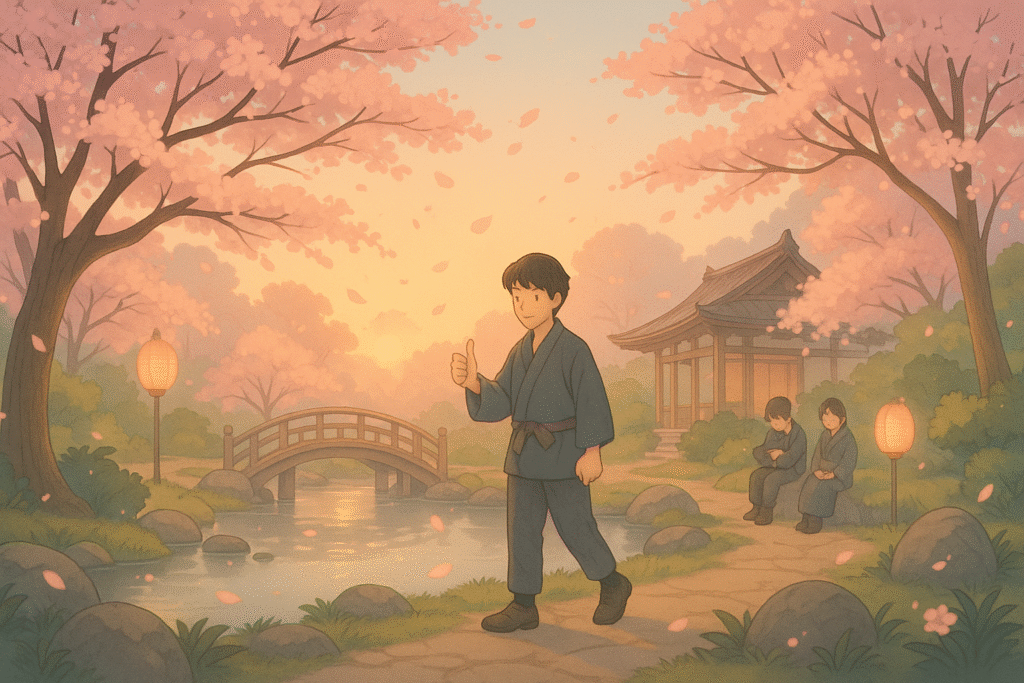Have you ever watched a Japanese anime where characters talk about cherry blossoms with such poetry that it makes your heart flutter? Or perhaps you’ve wondered why spring holds such a special place in Japanese culture that entire festivals revolve around flower viewing? Understanding spring in Japanese goes far beyond simple vocabulary—it’s about connecting with the soul of Japan itself.
Spring represents renewal, hope, and beauty in Japanese culture, making it one of the most linguistically rich seasons to explore. Whether you’re preparing for your JLPT N5 exam or simply want to appreciate Japanese poetry, mastering spring vocabulary will transform how you experience this magical season.
Why Learning Spring in Japanese Matters More Than You Think
When you learn spring in Japanese, you’re not just memorizing words—you’re unlocking centuries of cultural significance. From ancient poetry to modern conversations, spring vocabulary appears everywhere in Japanese language and culture. This knowledge becomes especially valuable when traveling to Japan during cherry blossom season or engaging with Japanese media.
Understanding seasonal vocabulary also enhances your overall Japanese fluency. Native speakers use these terms naturally in daily conversation, weather reports, and social media posts. By mastering these expressions, you’ll sound more natural and culturally aware.
Essential Spring in Japanese: Core Vocabulary You Must Know
The Foundation: Basic Spring Terms
Haru (春) serves as your starting point for everything related to spring in Japanese. This fundamental word appears in countless compound expressions and everyday conversations.
- Haru (春) – Spring
- Pronunciation: HAH-roo
- Example: 春が来ました (Haru ga kimashita) – “Spring has arrived”
- Haruichiban (春一番) – First spring storm
- Usage: Weather forecasters use this term to announce spring’s official arrival
- Cultural note: This warm, strong wind signals winter’s end
Cherry Blossom Vocabulary: The Heart of Spring in Japanese
No discussion of spring in Japanese is complete without cherry blossom terminology. These words capture Japan’s most beloved seasonal celebration.
Sakura (桜) – Cherry blossoms
- Shidarezakura (枝垂れ桜) – Weeping cherry trees
- Yozakura (夜桜) – Night-time cherry blossom viewing
- Sakurafubuki (桜吹雪) – Cherry blossom blizzard (falling petals)
Hanami (花見) – Cherry blossom viewing This cultural practice involves picnicking under blooming trees, often with friends, family, or coworkers. Understanding this concept is crucial for anyone interested in Japanese culture.
Advanced Spring in Japanese: Poetic and Cultural Expressions
Weather and Nature Terms
Learning weather-related vocabulary enhances your ability to discuss spring in Japanese naturally:
- Harukaze (春風) – Spring breeze
- Sample sentence: 春風が気持ちいいです (Harukaze ga kimochi ii desu) – “The spring breeze feels pleasant”
- Shunshoku (春色) – Spring colors
- Usage: Describes the soft pinks, yellows, and greens of the season
Seasonal Activities and Events
Shingakki (新学期) – New school term Japanese schools begin in April, making this term essential for understanding Japanese academic culture.
Haruyasumi (春休み) – Spring vacation Students enjoy this break before the new academic year begins.
Want to explore Japan’s culture?
Discover Japan’s rich culture, traditions, and hidden gems with our expertly crafted guides. Get insider tips on travel, food, and history. All for free!
Practical Applications: Using Spring in Japanese Daily
Conversation Starters
Master these phrases to discuss spring in Japanese naturally:
- 桜はいつ咲きますか?(Sakura wa itsu sakimasu ka?) – “When do the cherry blossoms bloom?”
- 花見に行きませんか?(Hanami ni ikimasen ka?) – “Would you like to go cherry blossom viewing?”
Social Media and Modern Usage
Young Japanese people frequently use spring vocabulary on social platforms. Understanding these terms helps you engage with contemporary Japanese culture.
Common Challenges When Learning Spring in Japanese
Pronunciation Pitfalls
Many learners struggle with the subtle differences in pronunciation. Practice these troublesome pairs:
- Hana (花) vs. Hana (鼻) – flower vs. nose
- Sakura (桜) – remember the clear “u” sound at the end
Cultural Context Confusion
Simply knowing the words isn’t enough—understanding when and how to use them matters equally. For example, hanami isn’t just “looking at flowers”; it’s a specific cultural activity with social protocols.
Mastering Spring in Japanese: Study Tips and Tricks
Memory Techniques
- Visual Association: Connect each word with vivid mental images
- Seasonal Immersion: Change your phone’s language to Japanese during spring
- Cultural Connection: Watch Japanese spring-themed movies or anime
Practice Exercises
Create flashcards pairing spring in Japanese vocabulary with photos of the actual scenes or objects. This visual connection strengthens memory retention significantly.
For comprehensive study materials and structured learning, consider our JLPT N5 Study Guide, which includes seasonal vocabulary alongside essential grammar patterns.
Beyond Vocabulary: Cultural Appreciation
Understanding spring in Japanese means appreciating concepts like mono no aware (the bittersweet awareness of impermanence) that cherry blossoms represent. This philosophical depth separates casual learners from those who truly connect with Japanese culture.
Like learning how to express politeness with “daijoubu” or understanding the cultural significance of greetings like “konbanwa”, mastering spring vocabulary requires cultural sensitivity alongside linguistic knowledge.
Quick Reference: Must-Know Spring in Japanese Terms
Essential words for spring in Japanese include: Haru (spring), Sakura (cherry blossoms), Hanami (flower viewing), and Harukaze (spring breeze).
- Spring season: 春 (Haru)
- Cherry blossoms: 桜 (Sakura)
- Flower viewing: 花見 (Hanami)
- Spring wind: 春風 (Harukaze)
- Full bloom: 満開 (Mankai)
- Spring holiday: 春休み (Haruyasumi)
Frequently Asked Questions About Spring in Japanese
Q: What’s the most important word to know for spring in Japanese? A: Haru (春) is the fundamental word for spring, appearing in most spring-related vocabulary.
Q: When is cherry blossom season in Japan? A: Cherry blossom season typically occurs from late March to early May, varying by region.
Q: How do you say “cherry blossom viewing” in Japanese? A: Hanami (花見) refers to the traditional practice of viewing and celebrating cherry blossoms.
Q: What’s the difference between sakura and hana? A: Sakura (桜) specifically means cherry blossoms, while hana (花) is the general word for flower.
Q: Are there polite forms for spring vocabulary? A: Most spring vocabulary remains the same in polite conversation, but sentence structure and verb forms change for politeness levels.
Mastering spring in Japanese opens doors to deeper cultural appreciation and more natural conversation. Whether you’re planning a trip during cherry blossom season or simply want to understand Japanese poetry better, this vocabulary forms the foundation for meaningful connections with Japanese culture and people.
Love Japan? Stay in the Loop!
Get the best of Japan straight to your inbox: language, culture & travel insights!




